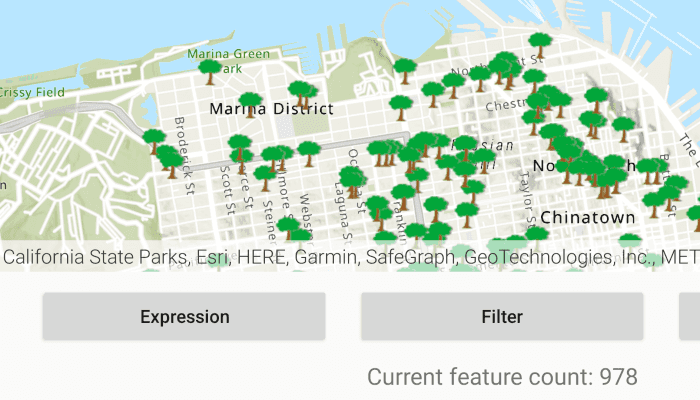Filter features displayed on a map using a definition expression or a display filter.

Use case
Definition queries allow you to define a subset of features to work with in a layer by filtering which features are retrieved from the dataset by the layer. This means that a definition query affects not only drawing, but also which features appear in the layer's attribute table and therefore which features can be selected, labeled, identified, and processed by geoprocessing tools.
Alternatively, display filters limit which features are drawn, but retain all features in queries and when processing. Definition queries and display filters can be used together on a layer, but definition queries limit the features available in the layer, while display filters only limit which features are displayed.
In this sample you can filter a dataset of tree quality selecting for only those trees which require maintenance or are damaged.
How to use the sample
Press the apply expression button to limit the features requested from the feature layer to those specified by the SQL query definition expression. This option not only narrows down the results that are drawn, but also removes those features from the layer's attribute table. To filter the results being drawn without modifying the attribute table, hit the button to apply the filter instead. Click the reset button to remove the definition expression or display filter on the feature layer, which returns all the records.
The feature count value shows the current number of features in the current map view extent. When a definition expression is applied to narrow down the list of features being drawn, the count is updated to reflect this change. However if a display filter is applied, the features which are not visible on the map will still be included in the total feature count.
How it works
- Create a service feature table from a URL.
- Create a feature layer from the service feature table.
- Filter features on your feature layer using a
FeatureLayer.definitionExpressionto view a subset of features and modify the attribute table. - Filter features on your feature layer using a
FeatureLayer.displayFilterDefinitionto view a subset of features without modifying the attribute table.
Relevant API
- DefinitionExpression
- FeatureLayer
- ServiceFeatureTable
About the data
The San Francisco 311 incidents layer in this sample displays point features related to crime incidents such as grafitti and tree damage that have been reported by city residents.
Tags
definition expression, display filter, filter, limit data, query, restrict data, SQL, where clause
Sample Code
/* Copyright 2022 Esri
*
* Licensed under the Apache License, Version 2.0 (the "License");
* you may not use this file except in compliance with the License.
* You may obtain a copy of the License at
*
* http://www.apache.org/licenses/LICENSE-2.0
*
* Unless required by applicable law or agreed to in writing, software
* distributed under the License is distributed on an "AS IS" BASIS,
* WITHOUT WARRANTIES OR CONDITIONS OF ANY KIND, either express or implied.
* See the License for the specific language governing permissions and
* limitations under the License.
*
*/
package com.esri.arcgisruntime.sample.filterbydefinitionexpressionordisplayfilter
import android.os.Bundle
import android.util.Log
import android.widget.Button
import android.widget.TextView
import android.widget.Toast
import androidx.appcompat.app.AppCompatActivity
import com.esri.arcgisruntime.ArcGISRuntimeEnvironment
import com.esri.arcgisruntime.data.QueryParameters
import com.esri.arcgisruntime.data.ServiceFeatureTable
import com.esri.arcgisruntime.geometry.Point
import com.esri.arcgisruntime.geometry.SpatialReferences
import com.esri.arcgisruntime.layers.DisplayFilter
import com.esri.arcgisruntime.layers.FeatureLayer
import com.esri.arcgisruntime.layers.ManualDisplayFilterDefinition
import com.esri.arcgisruntime.loadable.LoadStatus
import com.esri.arcgisruntime.mapping.ArcGISMap
import com.esri.arcgisruntime.mapping.BasemapStyle
import com.esri.arcgisruntime.mapping.Viewpoint
import com.esri.arcgisruntime.mapping.view.MapView
import com.esri.arcgisruntime.sample.filterbydefinitionexpressionordisplayfilter.databinding.ActivityMainBinding
class MainActivity : AppCompatActivity() {
private val TAG = MainActivity::class.java.simpleName
private val activityMainBinding by lazy {
ActivityMainBinding.inflate(layoutInflater)
}
private val featureCountTV: TextView by lazy {
activityMainBinding.featureCountTV
}
private val expressionButton: Button by lazy {
activityMainBinding.expressionButton
}
private val filterButton: Button by lazy {
activityMainBinding.filterButton
}
private val resetButton: Button by lazy {
activityMainBinding.resetButton
}
private val mapView: MapView by lazy {
activityMainBinding.mapView
}
override fun onCreate(savedInstanceState: Bundle?) {
super.onCreate(savedInstanceState)
setContentView(activityMainBinding.root)
// authentication with an API key or named user is required to access basemaps and other
// location services
ArcGISRuntimeEnvironment.setApiKey(BuildConfig.API_KEY)
// set the FeatureLayer using FeatureTable created from the URL to an ArcGIS feature service
val featureLayer =
FeatureLayer(ServiceFeatureTable("https://services2.arcgis.com/ZQgQTuoyBrtmoGdP/arcgis/rest/services/SF_311_Incidents/FeatureServer/0"))
// set the map to be displayed in the layout's MapView
// with the BasemapStyle topographic
val topographicMap = ArcGISMap(BasemapStyle.ARCGIS_TOPOGRAPHIC).apply {
//add a feature layer to the map
operationalLayers.add(featureLayer)
}
mapView.apply {
map = topographicMap
val viewpoint =
Viewpoint(Point(-122.4401, 37.7722, SpatialReferences.getWgs84()), 100000.0)
setViewpoint(viewpoint)
// run countFeatures() when MapView is finished moving
addNavigationChangedListener {
if (!isNavigating)
countFeatures(featureLayer)
}
}
expressionButton.setOnClickListener {
featureLayer.apply {
// Reset the display filter definition
displayFilterDefinition = null
// Set the definition expression to show specific features only
definitionExpression = "req_Type = 'Tree Maintenance or Damage'"
}
countFeatures(featureLayer)
}
filterButton.setOnClickListener {
featureLayer.apply {
// Disable the feature layer definition expression
definitionExpression = ""
// create a display filter and display filter definition
// req_type here is one of the published fields
val damagedTrees =
DisplayFilter("Damaged Trees", "req_type LIKE '%Tree Maintenance%'")
// Set the display filter definition on the layer
displayFilterDefinition =
ManualDisplayFilterDefinition(damagedTrees, listOf(damagedTrees))
}
countFeatures(featureLayer)
}
resetButton.setOnClickListener {
featureLayer.apply {
// Disable the feature layer definition expression
definitionExpression = ""
// Reset the display filter definition
displayFilterDefinition = null
}
countFeatures(featureLayer)
}
}
/**
* Retrieves the totalFeatureCount from the [featureLayer]'s current
* featureTable in the [mapView]'s extent
*/
private fun countFeatures(featureLayer: FeatureLayer) {
// Get the extent of the current viewpoint, return if no valid extent.
val extent =
mapView.getCurrentViewpoint(Viewpoint.Type.BOUNDING_GEOMETRY).targetGeometry.extent
?: return
// Update the UI with the count of features in the extent
val queryParameters = QueryParameters().apply {
geometry = extent
}
val featureCountFuture = featureLayer.featureTable.queryFeatureCountAsync(queryParameters)
featureCountFuture.addDoneListener {
if (featureLayer.featureTable.loadStatus == LoadStatus.LOADED) {
val totalFeatureCount = featureCountFuture.get()
featureCountTV.text = "Current feature count: $totalFeatureCount"
} else {
val errorMessage =
"Error receiving total feature count: ${featureLayer.featureTable.loadError.message}"
Log.e(TAG, errorMessage)
Toast.makeText(this@MainActivity, errorMessage, Toast.LENGTH_SHORT).show()
}
}
}
override fun onPause() {
mapView.pause()
super.onPause()
}
override fun onResume() {
super.onResume()
mapView.resume()
}
override fun onDestroy() {
mapView.dispose()
super.onDestroy()
}
}